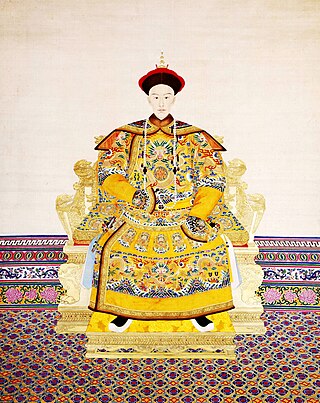This article needs additional citations for verification .(September 2018) |
| |||||
| Decades: | |||||
|---|---|---|---|---|---|
| See also: | Other events of 1873 History of China • Timeline • Years | ||||
Events from the year 1873 in China.
This article needs additional citations for verification .(September 2018) |
| |||||
| Decades: | |||||
|---|---|---|---|---|---|
| See also: | Other events of 1873 History of China • Timeline • Years | ||||
Events from the year 1873 in China.

The Guangxu Emperor, temple name Emperor Dezong of Qing, personal name Aisin-Gioro Zaitian, was the tenth Emperor of the Qing dynasty, and the ninth Qing emperor to rule over China proper. His reign lasted from 1875 to 1908, but in practice he ruled, without his aunt Empress Dowager Cixi's influence, only from 1889 to 1898. He initiated the Hundred Days' Reform, but was abruptly stopped when the empress dowager launched a coup in 1898, after which he became powerless and was held under house arrest until his death by poisoning. His era name, 光緒; 'Guangxu', means "glorious succession".

The Tongzhi Emperor, temple name Emperor Muzong of Qing, born Aisin-Gioro Zaichun, was the ninth Emperor of the Qing dynasty, and the eighth Qing emperor to rule over China proper. His reign, from 1861 to 1875, which effectively lasted through his adolescence, was largely overshadowed by the rule of his mother, Empress Dowager Cixi. Although he had little influence over state affairs, the events of his reign gave rise to what historians call the "Tongzhi Restoration", an unsuccessful modernization program.

The Xianfeng Emperor, or by temple name Emperor Wenzong of Qing (清文宗), given name Aisin-Gioro Yizhu (奕詝), was the eighth emperor of the Qing dynasty, and the seventh Qing emperor to rule over China proper, reigned from 1850 to 1861. During his reign, the Qing dynasty experienced several wars and rebellions including the Taiping Rebellion, Nian Rebellion, and Second Opium War. He was the last Chinese emperor to exercise sole power. After his death, the Qing government came under the control of Empress Dowager Cixi.
The Tongzhi Restoration was an attempt to arrest the dynastic decline of the Qing dynasty by restoring the traditional order. The harsh realities of the Opium War, the unequal treaties, and the mid-century mass uprisings of the Taiping Rebellion caused Qing officials to recognize the need to strengthen China. The Tongzhi Restoration was named for the Tongzhi Emperor, and was engineered by the young emperor's mother, the Empress Dowager Cixi (1835–1908). The restoration, however, which applied "practical knowledge" while reaffirming the old mentality, was not a genuine program of modernization. Academics are divided as to whether the Tongzhi Restoration arrested the dynastic decline or merely delayed its inevitable occurrence.

The Miao Rebellion of 1795–1806 was an anti-Qing uprising in Hunan and Guizhou provinces, during the reign of the Qianlong Emperor and Jiaqing Emperor. It was catalyzed by tensions between local populations and Han Chinese immigrants. Bloodily suppressed, it served as the antecedent to the much larger uprising of Miao Rebellion (1854–73).
Numerous rebellions against China's Qing dynasty took place between the mid-19th and early 20th centuries, prior to the abdication of the last Emperor of China, Puyi, in February 1912. The table below lists some of these uprisings and important related events.
The Miao rebellion of 1854–1873, also known as the Qian rebellion was an uprising of ethnic Miao and other groups in Guizhou province during the reign of the Qing dynasty. Despite its name, Robert Jenks estimates that ethnic Miao made up less than half of the uprising's participants. The uprising was preceded by Miao rebellions in 1735–36 and 1795–1806, and was one of many ethnic uprisings sweeping China in the 19th century. The rebellion spanned the Xianfeng and Tongzhi periods of the Qing dynasty, and was eventually suppressed with military force. Estimates place the number of casualties as high as 4.9 million out of a total population of 7 million, though these figures are likely overstated.
Events from the year 1872 in China.
Events from the year 1861 in China.
Events from the year 1868 in China.
Events from the year 1857 in China.
Events from the year 1862 in China.
Events from the year 1863 in China.
Events from the year 1864 in China.
Events from the year 1865 in China.
Events from the year 1866 in China.
Events from the year 1867 in China.
Events from the year 1869 in China.
Events from the year 1870 in China.
Events from the year 1871 in China.